Monthly Archives: February 2023

 I think that we can all say that we have found ourselves on the wrong side of history…at the very least our belief system. That is really where most of the world found themselves when Adolf Hitler was elected to office, and almost immediately began to pour out his evil plan for the world, and his hatred for anyone not Aryan, which in Nazi ideology, “denotes white non-Jewish people, especially those of northern European origin or descent typically having blond hair and blue eyes and regarded as a supposedly superior racial group.” Hitler had so deceived the world, in fact, that just a short six and a half months before Hitler invaded Poland, New York City’s Madison Square Garden hosted a rally to celebrate the rise of Nazism in Germany!! More than 20,000 people were in attendance. They raised Nazi salutes toward a 30-foot-tall portrait of George Washington flanked by swastikas. Of course, not everyone was fooled by Hitler, and in fact the 20,000 were a very small percentage, but these 20,000 were, whether they ever understood it or not, on the wrong side of history, trying to follow a man who was insanely evil, murderous, and racist. Outside, police and some 100,000 protestors, who saw right through Hitler’s beliefs, gathered.
I think that we can all say that we have found ourselves on the wrong side of history…at the very least our belief system. That is really where most of the world found themselves when Adolf Hitler was elected to office, and almost immediately began to pour out his evil plan for the world, and his hatred for anyone not Aryan, which in Nazi ideology, “denotes white non-Jewish people, especially those of northern European origin or descent typically having blond hair and blue eyes and regarded as a supposedly superior racial group.” Hitler had so deceived the world, in fact, that just a short six and a half months before Hitler invaded Poland, New York City’s Madison Square Garden hosted a rally to celebrate the rise of Nazism in Germany!! More than 20,000 people were in attendance. They raised Nazi salutes toward a 30-foot-tall portrait of George Washington flanked by swastikas. Of course, not everyone was fooled by Hitler, and in fact the 20,000 were a very small percentage, but these 20,000 were, whether they ever understood it or not, on the wrong side of history, trying to follow a man who was insanely evil, murderous, and racist. Outside, police and some 100,000 protestors, who saw right through Hitler’s beliefs, gathered.
The organization who was behind the February 20, 1939 event, was the German American Bund (“Bund” is German for “federation”), had advertised the event as a “Pro American Rally.” The antisemitic organization held Nazi summer camps for youth and their families during the 1930s. Doesn’t that sound a lot like Hitler’s Youth Camps, that later turned into just the Hitler Youth, where he forcefully took children from their parents saying that the parents were ill-equipped to properly raise their children. Then, he turned those youth into killing machines, with no regard for human life. The Bund’s youth members were present at the February 20th rally, as were the Ordnungsdienst, or OD, the group’s vigilante police force who dressed in the style of Hitler’s SS officers. In Germany, these were the Jewish Ghetto Police or Jewish Police Service (German: Jüdische, Ghetto-Polizei, or Jüdischer Ordnungsdienst), also called the Jewish Police by Jews, and they were auxiliary police units organized within the Nazi ghettos by local Judenrat (Jewish councils). Their “job” was to keep order, or rather monitor the orderly persecution and murder of the Jewish people.
At the rally, there were banners hanging with messages like “Stop Jewish Domination of Christian Americans” and “Wake Up America. Smash Jewish Communism.” When the Bund’s national leader, Fritz Kuhn, gave his closing speech, he referred to President Franklin Delano Roosevelt as “Rosenfield” and Manhattan District Attorney Thomas Dewey as “Thomas Jewey.” Kuhn, a naturalized American who lost his citizenship during World War II, declared, “We, with American ideals, demand that our government shall be returned to the American people who founded it. If you ask what we are actively fighting for under our charter: First, a socially just, white, Gentile-ruled United States. Second, Gentile-controlled labor unions, free from Jewish Moscow-directed domination.” Isadore Greenbaum, a brave Jewish-American man, interrupted Kuhn’s speech by charging the stage in protest. Undaunted, the police and the vigilante force quickly tackled him and proceeded to beat him up on stage. The crowd cheered as they threw him off stage, pulling his pants down in the process. Police charged Greenbaum with disorderly conduct and gave him a $25 fine, which today would have equaled about $450. They were not only intent on inflicting pain, but also humiliation. They are people who have stepped into the insane world of evil. Definitely the wrong side of history.
At the time the rally took place, Hitler was completing his sixth concentration camp. The protesters, many of them Jewish Americans, were trying to call attention to what was happening in Germany, saying that it could happen in the United States. Their fliers proclaimed, “Don’t wait for the concentration camps—Act now!” Outside the rally, people carried signs with messages like “Smash Anti-Semitism” and “Give me a gas mask, I can’t stand the smell of Nazis.” The police responded to the protesters with violent attacks. The night was riddled with violence. One protester escaped a mounted police officer, by punching his horse in the face. As the rally broke up, some protesters slipped by the police to punch departing Nazis in the face.
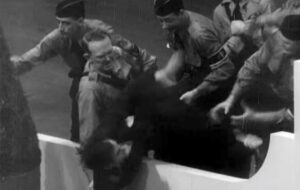
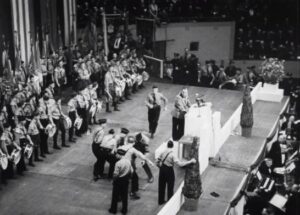 Looking back on how the Nazi history played out, and especially the atrocities of Hitler, I wonder if the people who were at the rally in support of Hitler felt about their…hero now. I suppose that being obsessed with evil, they might have been fine with the Holocaust, and all of the killing that took place. All we can hope is that maybe at least a few of then saw the error of their ways, and realized just how evil Hitler and the Third Reich really were.
Looking back on how the Nazi history played out, and especially the atrocities of Hitler, I wonder if the people who were at the rally in support of Hitler felt about their…hero now. I suppose that being obsessed with evil, they might have been fine with the Holocaust, and all of the killing that took place. All we can hope is that maybe at least a few of then saw the error of their ways, and realized just how evil Hitler and the Third Reich really were.

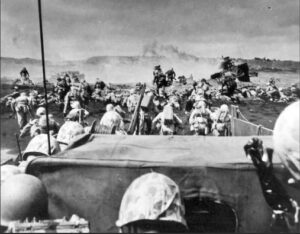 The taking of vital ground is an important, if not essential part of war. In World War II, Iwo Jima was vital ground. It was prime real estate on which to build airfields to launch bombing raids against Japan, just 660 miles away. The Japanese had it, and the Americans needed it. So, they devised a plan to evict the, then current occupiers, so they could have it. The planned attack was called Operation Detachment, and the plan was to invade Iwo Jima thus putting the Allies in a better position to attack Japan.
The taking of vital ground is an important, if not essential part of war. In World War II, Iwo Jima was vital ground. It was prime real estate on which to build airfields to launch bombing raids against Japan, just 660 miles away. The Japanese had it, and the Americans needed it. So, they devised a plan to evict the, then current occupiers, so they could have it. The planned attack was called Operation Detachment, and the plan was to invade Iwo Jima thus putting the Allies in a better position to attack Japan.
The problem was that Iwo Jima was well fortified, both above and below ground…with a force that was 21,000 strong. The US Marines had to find out where the Japanese strongholds were on the island, so the invasion would take place is several phases. The United States had to be patient in the days leading up to the actual invasion, but they also had to apply pressure to keep the Japanese off guard.
To apply pressure, the Americans began bomber raids using B-24 and B-25 bombers in June 1944. The raids continued for 74 days. It was the longest pre-invasion bombardment of the war. Anytime bombing continues for that long, it has to be stressful for those in the bomb zone. The constant threat of falling bombs, and never knowing if they will land on you next, would make every day stressful. The bombing was necessary because of the extent to which the Japanese fortification of the island, above and below ground, including a network of caves.
Next came the Frogmen phase. “Frogmen” or Underwater Demolition Teams were dispatched by the Americans just before the actual invasion. The plan was to for the frogmen to draw fire from the Japanese, thus giving away many of their “secret” gun positions. Of course, as you can imagine, this was basically a suicide mission for the Underwater Demolition Teams. The amphibious landings of Marines began the morning of February 19, 1945, as the secretary of the navy, James Forrestal, accompanied by journalists, surveyed the scene from a command ship offshore. As the Marines made their way onto the island, seven Japanese battalions opened fire on them. By evening, more than 550 Marines were dead and more than 1,800 were wounded. It took four more days and many more casualties to capture of Mount Suribachi, the highest point of the island and bastion of the Japanese defense. While the taking of Iwo Jima was vital and those who fought and died there willingly gave 
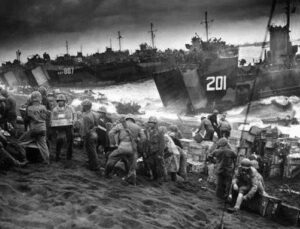 their lives for it, I have to think that it was a bittersweet victory, because of so many lives lost. Much like the D-Day storming of the beaches of Normandy, Iwo Jima was a suicide mission that was vital to the outcome of the war. The photo of the raising of the American flag on Iwo Jima, won the Pulitzer Prize for the photographer who took it, but I’m sure it was a photograph he would rather not have taken, considering the loss of life.
their lives for it, I have to think that it was a bittersweet victory, because of so many lives lost. Much like the D-Day storming of the beaches of Normandy, Iwo Jima was a suicide mission that was vital to the outcome of the war. The photo of the raising of the American flag on Iwo Jima, won the Pulitzer Prize for the photographer who took it, but I’m sure it was a photograph he would rather not have taken, considering the loss of life.

 My grandnephew, Easton Moore is pretty much all about his Bronco…except for his girl, Brionna Petrich, that is. For the past year, Easton has been busy working and fixing up his bronco. A year ago, he took his Bronco to Billings on his birthday weekend, and the alternator went out on the interstate by Laurel, Montana. Funny how stuff like that always seems to happen when you are out of town. The breakdown meant that he had to have it towed to get it off the interstate. Then a call to his parents, and they helped him get it home. That episode inspired Easton to replace the old alternator with a bigger alternator. Easton had put new subwoofers in, and the bigger alternator would help out with power for that. In the end, Easton’s dad, Steve Moore had to do a little engineering for it to work, but now, it works great!! With the power problem handled, Easton moved on to his next project, the carpet and a new muffler, or that’s what he thought was going to be the next project, but because some other things came up that needed done first, those would have to wait.
My grandnephew, Easton Moore is pretty much all about his Bronco…except for his girl, Brionna Petrich, that is. For the past year, Easton has been busy working and fixing up his bronco. A year ago, he took his Bronco to Billings on his birthday weekend, and the alternator went out on the interstate by Laurel, Montana. Funny how stuff like that always seems to happen when you are out of town. The breakdown meant that he had to have it towed to get it off the interstate. Then a call to his parents, and they helped him get it home. That episode inspired Easton to replace the old alternator with a bigger alternator. Easton had put new subwoofers in, and the bigger alternator would help out with power for that. In the end, Easton’s dad, Steve Moore had to do a little engineering for it to work, but now, it works great!! With the power problem handled, Easton moved on to his next project, the carpet and a new muffler, or that’s what he thought was going to be the next project, but because some other things came up that needed done first, those would have to wait.
Easton graduated from high school in May of 2022. With apartment rent as high as it is, he is still living at home, which doesn’t hurt his parents’ feelings any. He is enjoying the freedom of not having schoolwork to do, and his mom is too. Its not that she had to help him so much, but there is always that push to get your kid to study, and get their homework done. While he did well in school, parents still have the job of chief encourager and supervisor. Now that is behind them, and if Easton decides to go further in his education, it will be on his own. Time will tell, but he happy with things as is for now.
Since graduation, Easton and his dad have collected all the parts to add a lift to his Bronco, so that he can use the tires he got from his friend…big wide tires. I don’t know what it is with guys, but the mor a vehicle looks monster truck like, the happier they are. Easton hated the wait to get the money together and then the wait to have the lift installed, but he persevered, and saving the money for your purchases is a great financial lesson to learn. Once the lift was all done, Easton couldn’t wait to take it for a drive, and wouldn’t you just know it…the starter quit working. That was odd, because he had just bought the starter, but it wouldn’t stay tight. As it turns out, there was a crack in the bell housing to the transmission. Oh, the joys of vehicle ownership!!
Thankfully, Easton has a good friend that actually found a replacement bell housing, located just a half a block away, and for just $100!! He was back in business. Easton and his friend finished taking it out of the Bronco, and Steve got it all taken apart and put all the parts into the new bell housing. The new on was perfect, with no cracks and nothing previously repaired (rebuilt). Finally, after all the parts were put back in, they took it for a drive. That first drive showed that there were still problems. It would only work in first and reverse. Now, that makes it difficult to dive it very far. A couple days later and lots of research, Easton took it back out and “Gave it the Onion.” Now, all the gears work great!! He then took it down to get the tires aligned right, since installing the lift. The carpet and the muffler will still be in the future, having been push out for other things.
If there is one thing that can be said about Easton, it’s that he is ambitious. He decides that he is going to do something, and he sticks to it until he accomplishes what he set out to accomplish. He has the determination to meet his goals even when life throws him a bunch of lemons!! His parents are so very proud of how he has worked through the hard times to make it to the good times! Easton has found a great supporter through it all…
 his girlfriend, Brionna. She makes him happy, always smiling, and the two of them together makes everything good. When you have a good support system, you can accomplish anything you set your mind to!! Everyone needs a great support system. Today is Easton’s birthday. Happy birthday Easton!! Have a great day!! We love you!!
his girlfriend, Brionna. She makes him happy, always smiling, and the two of them together makes everything good. When you have a good support system, you can accomplish anything you set your mind to!! Everyone needs a great support system. Today is Easton’s birthday. Happy birthday Easton!! Have a great day!! We love you!!

 On October 31, 1922, following the March on Rome, Benito Mussolini was appointed prime minister by King Victor Emmanuel III. With that appointment, he became the youngest individual to hold the office up to that time. Mussolini quickly got to work, removing all political opposition through his secret police and outlawing labor strikes. He, along with his followers consolidated power through a series of laws that transformed Italy into a one-party dictatorship. A short five years later, he had established dictatorial authority by both legal and illegal means and planned to create a totalitarian state.
On October 31, 1922, following the March on Rome, Benito Mussolini was appointed prime minister by King Victor Emmanuel III. With that appointment, he became the youngest individual to hold the office up to that time. Mussolini quickly got to work, removing all political opposition through his secret police and outlawing labor strikes. He, along with his followers consolidated power through a series of laws that transformed Italy into a one-party dictatorship. A short five years later, he had established dictatorial authority by both legal and illegal means and planned to create a totalitarian state.
Still, as often happens, the people, good government officials, and of course, God made it clear that both fascist Italy and its dictator Benito Mussolini’s days were numbered by July 1943. So, after the successful Allied invasion of Sicily, the Italian government’s Grand Council delivered Mussolini a vote of no confidence. Shortly after that, King Vittorio Emanuele III replaced Mussolini as prime minister, and immediately had him arrested.
When Adolf Hitler heard of Mussolini’s arrest, he was furious. Hitler considered Mussolini to be his most powerful European ally, and Hitler began to make plans to rescue Mussolini. He brought in SS Major Otto Skorzeny, who was considered “the most dangerous man in Europe,” for the rescue mission. The Germans had 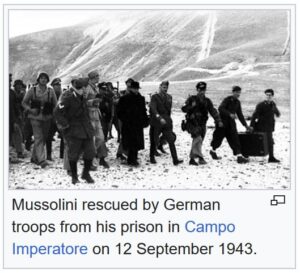 discovered that Mussolini was being held in a mountain ski resort 7,000 feet above sea level in the Abruzzo region. Due to the remoteness of the location, Skorzeny decided the only way to rescue Mussolini was to send in a dozen gliders with 108 commandos to do the job. The mission, dubbed Operation Eiche commenced on September 12, 1943. Along with the commandos, Skorzeny brought along an Italian general named Soleti. It was Soleti’s mission to create confusion among Mussolini’s guards, thereby giving the commandos time to get to Mussolini. While Soleti shouted orders at the confused guards, the commandos recaptured Mussolini without incident and flew him to a nearby Luftwaffe airfield, then to Hitler’s Wolf’s Lair headquarters in East Prussia.
discovered that Mussolini was being held in a mountain ski resort 7,000 feet above sea level in the Abruzzo region. Due to the remoteness of the location, Skorzeny decided the only way to rescue Mussolini was to send in a dozen gliders with 108 commandos to do the job. The mission, dubbed Operation Eiche commenced on September 12, 1943. Along with the commandos, Skorzeny brought along an Italian general named Soleti. It was Soleti’s mission to create confusion among Mussolini’s guards, thereby giving the commandos time to get to Mussolini. While Soleti shouted orders at the confused guards, the commandos recaptured Mussolini without incident and flew him to a nearby Luftwaffe airfield, then to Hitler’s Wolf’s Lair headquarters in East Prussia.
While Mussolini was free now, this would not be the victory Mussolini had hoped for. The Germans installed Mussolini as the head of a puppet regime called the Italian Socialist Republic in the town of Salo. The position wasn’t much more than symbolic. The German press portrayed the rescue as a daring feat of bravery…at the time, but in 2016, Italian author Vincenzo Di Michele researched the raid and concluded that it was likely enabled by Mussolini sympathizers in the Italian government. Mussolini could not be allowed to be free, even to run a puppet regime, and so the Allies began their hunt for him. On April 25, 1945, Allied troops were advancing into northern Italy, and the collapse of the Salò Republic was imminent. Mussolini and his mistress Clara Petacci attempted to escape to Switzerland, intending to board a plane and escape to Spain. Two days later on April 27th, they were stopped near the village of Dongo (Lake Como) by communist partisans named 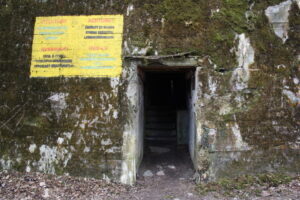
 Valerio and Bellini and identified by the Political Commissar of the partisans’ 52nd Garibaldi Brigade, Urbano Lazzaro. The next day, Mussolini and Petacci were both executed, along with most of the members of their 15-man train, primarily ministers and officials of the Italian Social Republic, in the small village of Giulino di Mezzegra by a partisan leader who used the name de guerre Colonnello Valerio (Not his real name, his real name remains unknown.)
Valerio and Bellini and identified by the Political Commissar of the partisans’ 52nd Garibaldi Brigade, Urbano Lazzaro. The next day, Mussolini and Petacci were both executed, along with most of the members of their 15-man train, primarily ministers and officials of the Italian Social Republic, in the small village of Giulino di Mezzegra by a partisan leader who used the name de guerre Colonnello Valerio (Not his real name, his real name remains unknown.)
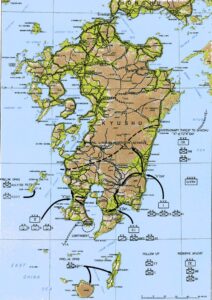 Near what is now known to be the end of World War II, a plan was devised to invade the Japanese home islands. In the end, Operation Downfall was not carried out, because Japan surrendered following the atomic bombings of Hiroshima and Nagasaki, the Soviet declaration of war, and the invasion of Manchuria. Nevertheless, in the days and months leading up to the planned attack, with its two parts…Operation Olympic and Operation Coronet, the United States Armed Forces ordered 1 million Purple Heart medals, in anticipation of a bloody battle. Operation Olympic was set to begin in November 1945, and was intended to capture the southern third of the southernmost
Near what is now known to be the end of World War II, a plan was devised to invade the Japanese home islands. In the end, Operation Downfall was not carried out, because Japan surrendered following the atomic bombings of Hiroshima and Nagasaki, the Soviet declaration of war, and the invasion of Manchuria. Nevertheless, in the days and months leading up to the planned attack, with its two parts…Operation Olympic and Operation Coronet, the United States Armed Forces ordered 1 million Purple Heart medals, in anticipation of a bloody battle. Operation Olympic was set to begin in November 1945, and was intended to capture the southern third of the southernmost 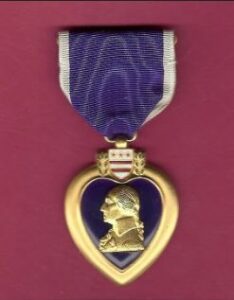 main Japanese island, Kyushu, with the recently captured island of Okinawa to be used as a staging area. The second attack was planned for early 1946. Operation Coronet was supposed to be the invasion of the Kanto Plain, near Tokyo, on the main Japanese island of Honshu. Important airbases on Kyushu that would be captured in Operation Olympic would allow land-based air support for Operation Coronet. If Downfall had taken place, it would have been the largest amphibious operation in history…even surpassing D-Day.
main Japanese island, Kyushu, with the recently captured island of Okinawa to be used as a staging area. The second attack was planned for early 1946. Operation Coronet was supposed to be the invasion of the Kanto Plain, near Tokyo, on the main Japanese island of Honshu. Important airbases on Kyushu that would be captured in Operation Olympic would allow land-based air support for Operation Coronet. If Downfall had taken place, it would have been the largest amphibious operation in history…even surpassing D-Day.
This planned set of attacks was no mystery to Japan either, because their geography made this invasion plan quite obvious. The Japanese were able to accurately predict the Allied invasion plans, and they adjusted their defensive plan, known as Operation  Ketsugo, accordingly. The Japanese planned an all-out defense of Kyushu, with little left in reserve for any subsequent defense operations. Casualty predictions varied widely, but they were expected to be extremely high. Depending on the degree to which Japanese civilians would have resisted the invasion, estimates ran up into the millions for Allied casualties. No wonder the United States expected to need 1 million Purple Heart medals. Thankfully, those millions of Allied casualties never materialized, because when the atomic bombs were dropped on Hiroshima and Nagasaki, the war ended. The United States was left with 1 million Purple Heart medals, which they are still using today. I think that while having 1 million Purple Heart medals isn’t the worst thing ever, just the fact that we still have some of those 1 million Purple Heart medals means that, in some way, we have kept some of our soldiers safe over the years. I don’t know how many are left, but it doesn’t matter, because at this point, 78 years later…there are some left.
Ketsugo, accordingly. The Japanese planned an all-out defense of Kyushu, with little left in reserve for any subsequent defense operations. Casualty predictions varied widely, but they were expected to be extremely high. Depending on the degree to which Japanese civilians would have resisted the invasion, estimates ran up into the millions for Allied casualties. No wonder the United States expected to need 1 million Purple Heart medals. Thankfully, those millions of Allied casualties never materialized, because when the atomic bombs were dropped on Hiroshima and Nagasaki, the war ended. The United States was left with 1 million Purple Heart medals, which they are still using today. I think that while having 1 million Purple Heart medals isn’t the worst thing ever, just the fact that we still have some of those 1 million Purple Heart medals means that, in some way, we have kept some of our soldiers safe over the years. I don’t know how many are left, but it doesn’t matter, because at this point, 78 years later…there are some left.
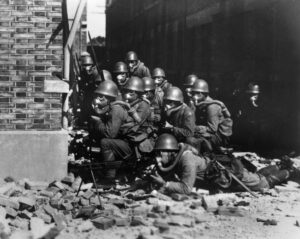 What would make a tiny nation try to invade a nation that is more that 25 times larger, with a population that is at least 8 times larger? It makes no sense, and yet on February 15, 1937, Japan attempted to invade China. Japan, with a total of 60,000 soldiers enter Northern China using planes and tanks. The invasion was something they had studied so they would have a plan before they attempted such an outlandish scheme. The type of conquest they were trying to mimic was that of Kubia Kahn, the Mongol emperor, who in 1271, established the Yuan dynasty and formally claimed orthodox succession from prior Chinese dynasties. The Yuan dynasty came to rule over most of present-day China, Mongolia, Korea, southern Siberia, and other adjacent areas. Kahn also amassed influence in the Middle East and Europe as khagan. By 1279, the Yuan conquest of the Song dynasty was completed, and Kahn became the first non-Han emperor to rule all of China proper.
What would make a tiny nation try to invade a nation that is more that 25 times larger, with a population that is at least 8 times larger? It makes no sense, and yet on February 15, 1937, Japan attempted to invade China. Japan, with a total of 60,000 soldiers enter Northern China using planes and tanks. The invasion was something they had studied so they would have a plan before they attempted such an outlandish scheme. The type of conquest they were trying to mimic was that of Kubia Kahn, the Mongol emperor, who in 1271, established the Yuan dynasty and formally claimed orthodox succession from prior Chinese dynasties. The Yuan dynasty came to rule over most of present-day China, Mongolia, Korea, southern Siberia, and other adjacent areas. Kahn also amassed influence in the Middle East and Europe as khagan. By 1279, the Yuan conquest of the Song dynasty was completed, and Kahn became the first non-Han emperor to rule all of China proper.
So, with dreams of power and world domination, among other things, including a need for the resources Japan lacked and China had, the Japanese army under Emperor Hirohito made the decision to attack the much larger  and more populated China. They threatened to bottle up 400,000 Chinese people on China’s central front. The attack area was approximately 20 miles, from the Yellow River to the Henan Capital provincial (Kaifeng). The Japanese Army displayed far superior air power and many more combat troops during the Japanese onslaught. In fact, their might could easily be called terrifying. China was helpless at stopping the Japanese forces from occupying Shanghai, and they were barely able prevent the invasion of Japan on the capital. The Chinese desperately tried to fight back with small caliber weapons against the heavy artillery fire power, air and naval might, and armored defenses of Japan. While they were severely outgunned, the bravery, stubbornness and determination of the Chinese made it possible for the country to withstand three months of defending Shanghai. Nevertheless, in the end, Shanghai fell, and Japan gained control over the city. The best of China’s troops were defeated. Still, the Japanese were surprised at the length of time that the Chinese troops were able to make a stand for their capital city. Because of their military superiority, the Japanese fully expected a short battle and a swift victory. They were not prepared for the one variable…the determination of the Chinese
and more populated China. They threatened to bottle up 400,000 Chinese people on China’s central front. The attack area was approximately 20 miles, from the Yellow River to the Henan Capital provincial (Kaifeng). The Japanese Army displayed far superior air power and many more combat troops during the Japanese onslaught. In fact, their might could easily be called terrifying. China was helpless at stopping the Japanese forces from occupying Shanghai, and they were barely able prevent the invasion of Japan on the capital. The Chinese desperately tried to fight back with small caliber weapons against the heavy artillery fire power, air and naval might, and armored defenses of Japan. While they were severely outgunned, the bravery, stubbornness and determination of the Chinese made it possible for the country to withstand three months of defending Shanghai. Nevertheless, in the end, Shanghai fell, and Japan gained control over the city. The best of China’s troops were defeated. Still, the Japanese were surprised at the length of time that the Chinese troops were able to make a stand for their capital city. Because of their military superiority, the Japanese fully expected a short battle and a swift victory. They were not prepared for the one variable…the determination of the Chinese 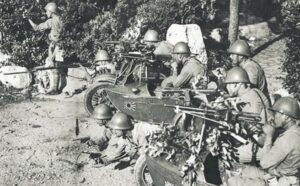 people. Morale plummeted over the heavy losses incurred, but not for long.
people. Morale plummeted over the heavy losses incurred, but not for long.
I sometimes wonder if these heads of governments really think that they can somehow control the world, or even, if they really think they can control the country they have invaded. The main reasons that nations and borders change as often as they do, is that people will only live under oppression for so long. Then, they will fight back. As to the heads of nations and ruling the world. While they might be the “head” of their nation, in a situation of world domination, I seriously doubt if any of these national leaders would be the one in control.

 Like most holidays, Valentine’s Day has different meanings for different groups of people. At one time, back in the 400s, it was to celebrate the coming of Spring. It was also a day to celebrate two saints named Valentine. It was a way of honoring them. These days, I think it is pretty much universally known as a holiday to celebrate love, and even friendship.
Like most holidays, Valentine’s Day has different meanings for different groups of people. At one time, back in the 400s, it was to celebrate the coming of Spring. It was also a day to celebrate two saints named Valentine. It was a way of honoring them. These days, I think it is pretty much universally known as a holiday to celebrate love, and even friendship.
Of course, the flower, candy, and greeting card industries, as well as the restaurant industry, have really profited from the Valentine’s Day tradition of showing our love, and I think that’s ok. While some people consider the day to be a forced display, I feel like it is a great way to show people how much they mean to you. I don’t really understand why people consider it a burden. In our family we always brought candy to our parents and siblings, and I love to continue that with my kids, grandkids, and great grandkids. To see the smiles on their faces, is all I need to feel happy.
With restaurants so busy on Valentine’s Day, my husband, Bob and I always choose a different day to go out for dinner. Many other people feel the same way, and with that, Valentine’s Day has essentially become Valentine’s week. If a couple is going to become engaged on Valentine’s Day, or get married on Valentine’s Day, then no other day will do. That makes sense too. I don’t know how I would feel about getting engaged or married on a holiday, but many people think it’s a great idea to mix the holiday with their special day. Of course, becoming engaged on those holidays is w very different thing. Still, to each his own, as they say. However, you choose to celebrate, or not celebrate Valentine’s Day, it will always be remembered as a day to 
 celebrate love.
celebrate love.
Whatever you decide to do, I hope you have a wonderful day, and if you decide to celebrate the coming of Spring, well…it’s truly just around the corner. And about that, I am completely happy. To my family, friends, and my love…Bob, I say Happy Valentine’s Day. May your day, or week be wonderful!!

 These days, it seems that every day is a designated “something” day, and some days might have multiple designations. Of course, we all know the main holidays, but the lesser-known days are pretty cool too. February 14th is Valentine’s Day, but did you know that February 13th is Galentine’s Day…which is a day for us to celebrate our girlfriends. Now I don’t mean romantic girlfriend, but rather like BFFs or Besties. You know a girl has to have her best friends, and the 13th of February is the day to say, “Hey, you’re my BFF, and I want you to know how important you are to me. Other national days that happen to fall on February 13th are, National Cheddar Day, Kiss Day, National Football Hangover Day, and National Tortellini Day…just to name a few.
These days, it seems that every day is a designated “something” day, and some days might have multiple designations. Of course, we all know the main holidays, but the lesser-known days are pretty cool too. February 14th is Valentine’s Day, but did you know that February 13th is Galentine’s Day…which is a day for us to celebrate our girlfriends. Now I don’t mean romantic girlfriend, but rather like BFFs or Besties. You know a girl has to have her best friends, and the 13th of February is the day to say, “Hey, you’re my BFF, and I want you to know how important you are to me. Other national days that happen to fall on February 13th are, National Cheddar Day, Kiss Day, National Football Hangover Day, and National Tortellini Day…just to name a few.
There are also National Weeks and Months as we all know. This week happen to be Nation Random Acts of Kindness Week, and I think that is a wonderful idea. After all, this world could use a little (or maybe a lot) more kindness. Random Acts of Kindness Week encourages people out there and show just how easy it is to give to others. This holiday is all about making kindness a standard for others to follow to make the world around us a nicer place to live.
One way to celebrate National Kindness Week is to show appreciation for those around us, seeing others with a need, and teaching our kids to practice kindness. It is celebrated on the second week of February, and it inspires people all over the world to make the lives of other people just a little bit better. Of course, people should be kind to each other all the time, and while many national days and weeks are for silly things, but this one is something that we should try to celebrate all year long, if you ask me. I think it’s even more fun to practice random acts of kindness anonymously.
The holiday week officially started through the Random Acts of Kindness (RAK) organization. It was designed to let people give back to others through random acts, whether that be taking a trip to Africa to feed the poor, show support for cancer patients, or helping someone on the road fix their flat tires. RAK, a non-profit organization, is located in Denver, Colorado, and consists of a small team that works hard to inspire others. The 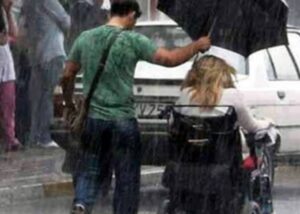
 RAK program offers resources for those wishing to participate during the week, including school programs, calendars, videos, and training materials. While that is great, people don’t have to be involved in a formal program to participate. All you need is a compassionate heart, a willingness to give, and a watchful eye, so you know when and who needs your own special brand of a random act of kindness.
RAK program offers resources for those wishing to participate during the week, including school programs, calendars, videos, and training materials. While that is great, people don’t have to be involved in a formal program to participate. All you need is a compassionate heart, a willingness to give, and a watchful eye, so you know when and who needs your own special brand of a random act of kindness.

 I don’t know about you, but when I hear “art museum,” I think of a stuffy old building with walls and walls of paintings on them…usually old paintings that, while probably priceless, are not something I would probably be interested in. I’m sure that is what many art museums look like, but not all of them do. Some art museums are actually very beautiful, like the Louvre, which is both beautiful and unique. Still other museums could only be classified as “different” and even strange!!
I don’t know about you, but when I hear “art museum,” I think of a stuffy old building with walls and walls of paintings on them…usually old paintings that, while probably priceless, are not something I would probably be interested in. I’m sure that is what many art museums look like, but not all of them do. Some art museums are actually very beautiful, like the Louvre, which is both beautiful and unique. Still other museums could only be classified as “different” and even strange!!
The Graz Art Museum is a futuristic-looking building in the heart of Graz, Austria, and this building will definitely catch your eye. The Graz Art Museum is not an old building, but it could be classified as historic…simply because of how it looks. The building is in the heart of Graz, but in reality, it is the Heart of Graz. It may not be called that, but it should be. This relatively “young” building was built in 2003 for the purpose of European Capital of Culture program. The really cool thing about this building is that it was built in the shape of a robotic heart, which makes it stand out from the typical Austrian architecture. The surface of the museum has almost 1000 fluorescent rings which create different patterns at night, and another cool thing is that most of the power energy of the museum comes from solar panels on the roof, making it much more inexpensive to operate.
Whether you’re an art fan or not, you must admit that this museum is, to say the least, interesting. The museum is really a work of art in itself. The round led lights that cover the exterior of the electronic heart shaped building…complete with the arteries…are lit at night to add a futuristic air to the building, displaying 
 different shapes and such on different nights. The interior is as futuristic as the exterior. Even the art that is on display is futuristic. The whole place has an almost “outer space” feel to it. I suppose it could be quite different on the inside, and if I were there in person, it might seem entirely like a normal museum, but I rather think not. I think it might be very difficult for this museum to be “normal” in any way.
different shapes and such on different nights. The interior is as futuristic as the exterior. Even the art that is on display is futuristic. The whole place has an almost “outer space” feel to it. I suppose it could be quite different on the inside, and if I were there in person, it might seem entirely like a normal museum, but I rather think not. I think it might be very difficult for this museum to be “normal” in any way.
 Evil can be just around the corner, and sadly, sometimes, the evil doers walk away without being punished for their crimes. On the morning of February 10, 1990, the staff at Las Cruces Bowl were busy getting ready for the Saturday bowling crowd, when two armed men walked in through an unlocked door. The men were there to rob the place. They could have worn masks, or they could have just robbed the place and fled the scene, but they had no intention of being caught, and that meant that they couldn’t leave witnesses.
Evil can be just around the corner, and sadly, sometimes, the evil doers walk away without being punished for their crimes. On the morning of February 10, 1990, the staff at Las Cruces Bowl were busy getting ready for the Saturday bowling crowd, when two armed men walked in through an unlocked door. The men were there to rob the place. They could have worn masks, or they could have just robbed the place and fled the scene, but they had no intention of being caught, and that meant that they couldn’t leave witnesses.
Stephanie C Senac, 34, who was the bowling alley manager, was in her office preparing to open the for the day. Her 12-year-old daughter Melissa Repass and Melissa’s 13-year-old friend Amy Houser were there to supervise the alley’s day care. The gunmen took them into the office, where they robbed them of a mere $4,000 to $5,000. As robberies go, it was practically nothing. When bowling alley mechanic Steven Teran came in with his two young daughters, Paula Holguin and Valerie Teran, they were totally unprepared for what faced them. Teran was unable to find a  babysitter for his daughters that day, so he had decided that he would drop them at the bowling alley daycare for the Melissa and Amy to watch. As the robbers took cash from the safe, the seven unfortunate people, including Teran and his daughters; cook Ida Holguin (no relation to Paula); manager Stephanie Senac, her daughter, and her daughter’s friend tried to be cooperative in the hope of making it out alive, but the men told them to get down on the ground. Then they shot all of the victims multiple times at close range, aiming mostly for their heads. When the shooting was over, they were still not satisfied with how things stood, so they set fire to some papers in the office of the bowling alley and left.
babysitter for his daughters that day, so he had decided that he would drop them at the bowling alley daycare for the Melissa and Amy to watch. As the robbers took cash from the safe, the seven unfortunate people, including Teran and his daughters; cook Ida Holguin (no relation to Paula); manager Stephanie Senac, her daughter, and her daughter’s friend tried to be cooperative in the hope of making it out alive, but the men told them to get down on the ground. Then they shot all of the victims multiple times at close range, aiming mostly for their heads. When the shooting was over, they were still not satisfied with how things stood, so they set fire to some papers in the office of the bowling alley and left.
Miraculously, Ida, Senac, and Melissa all survived. Melissa, despite being shot five times, was able to call 911. Unfortunately, the fire and subsequent efforts to put out the fire destroyed most of the evidence. In those days, forensics mostly involved fingerprints, which were in abundance in the bowling alley. DNA was not really as  developed at that time. Investigators were unable to discern which fingerprints were meaningful. There were witnesses, of course, who identified the suspects as two Hispanic men, in their 30s or 40s. Roadblocks were quickly set up by the police, to screen anyone leaving town. Still, the suspects were never found. Despite a frequent stream of tips, authorities are no closer to identifying and arresting the suspects today than they were 32 years ago…even with age enhanced pictures. The murders have been shown on multiple crime solving programs, including on Unsolved Mysteries two and a half months after the murders, and on America’s Most Wanted twice, once in November 2004 and again in March 2010. In the end, the crime also took the life of Stephanie Senac, who died in 1999…nine years later, due to complications from her injuries. The men got away with just $4,000 to $5,000, but the victims paid dearly.
developed at that time. Investigators were unable to discern which fingerprints were meaningful. There were witnesses, of course, who identified the suspects as two Hispanic men, in their 30s or 40s. Roadblocks were quickly set up by the police, to screen anyone leaving town. Still, the suspects were never found. Despite a frequent stream of tips, authorities are no closer to identifying and arresting the suspects today than they were 32 years ago…even with age enhanced pictures. The murders have been shown on multiple crime solving programs, including on Unsolved Mysteries two and a half months after the murders, and on America’s Most Wanted twice, once in November 2004 and again in March 2010. In the end, the crime also took the life of Stephanie Senac, who died in 1999…nine years later, due to complications from her injuries. The men got away with just $4,000 to $5,000, but the victims paid dearly.

